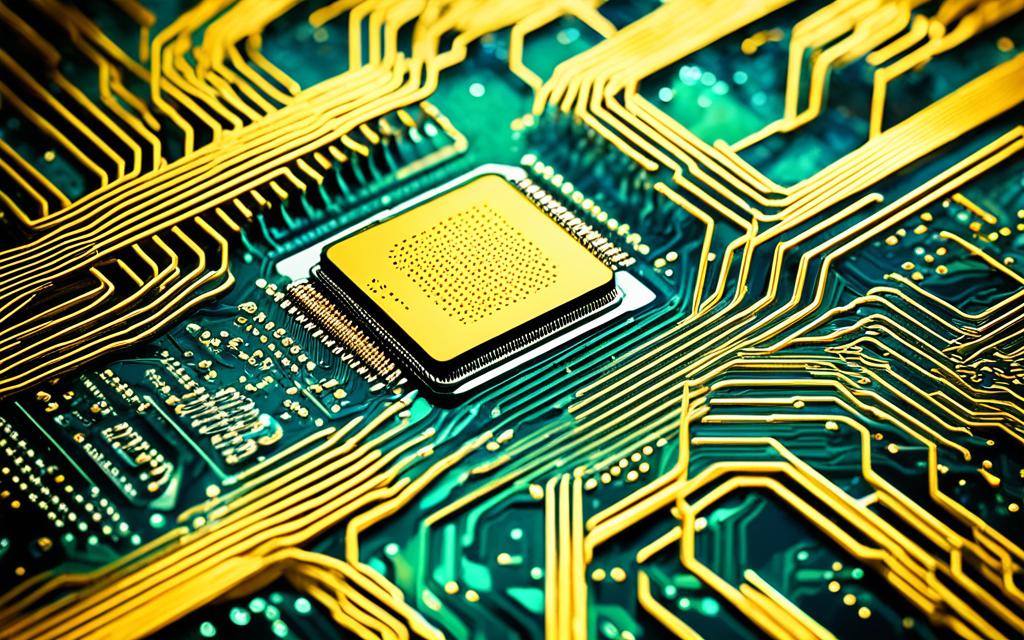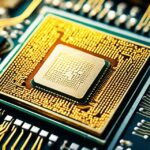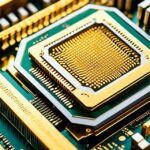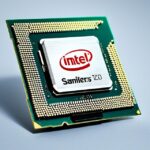Table of Contents
The hidden world of modern computing is full of surprises, and one fascinating fact is the gold inside a CPU. This gold is essential, not just a fancy addition. It helps make electronic devices work better and last longer. Gold is critical in various CPU parts, boosting performance and dependability1. This treasure, which many don’t notice, opens a window into how important gold has been in electronics over the years. It turns it into an intriguing topic to dive into.
When we learn about the gold in CPUs, we discover amazing things about computer engineering. We see how vital gold is for keeping devices running smoothly and lasting a long time.
Key Takeaways
- The gold amount in CPUs can be from 0.25 to 0.5 grams, but this varies widely2.
- CPUs made before 1990 often have more gold than the newer ones2.
- Gold is chosen for CPU parts because it conducts well and doesn’t rust1.
- Taking gold out of CPUs can get you 40% to 60% of its true value after it’s cleaned up, showing why professional methods are vital1.
- Some CPUs, like the Intel 386 and Pentium Pro, are especially valued for recycling because they have a lot of gold1.
The Importance of Gold in Electronics
Gold is key in electronics because of its special qualities. These qualities improve the function and life of important parts. The importance of gold in electronics comes from its great electrical conductivity and its ability not to rust. This makes it perfect for circuits that need to be reliable for a long time.
Exceptional Conductivity and Corrosion Resistance
Gold is better at conducting electricity than other metals like copper and silver. These other metals can get rusty3. Gold doesn’t tarnish because it doesn’t react with oxygen. This corrosion resistance is why gold helps electronic devices work well for longer3.
Role of Gold in Ensuring Reliability in CPUs
Gold is crucial for reliable electrical connections in CPUs. A typical computer has about 1/5th of a gram of gold, valued at around $12. This small amount is vital for the computer’s efficiency4. Gold can handle high temperatures without getting damaged. This keeps important connections safe during intense tasks. With today’s high-powered CPUs, this is very important for multitasking and efficiency. Click here for more info.
| Property | Gold | Copper | Silver |
|---|---|---|---|
| Electrical Conductivity | Highest | Moderate | High |
| Corrosion Resistance | Excellent | Poor | Moderate |
| Tarnishing | None | Yes | Yes |
| Workability | High | Moderate | High |
Gold’s unique features make CPUs reliable. This improves how electronics work for users. It shows why gold is unmatched in the industry4.
Components of a CPU Containing Gold
Gold is key in making CPUs work well. It works great for conducting electricity and doesn’t tarnish. So, it’s used a lot in designing CPUs.
Gold Plating on Pins and Connectors
Gold plating on CPU pins and connectors makes electrical connections better. It allows for quick data transfer. This plating helps the CPU perform well, even in tough conditions.
Internal Gold Bonding Wires
Inside the CPU, gold wires connect important parts. They are made from very pure gold. This helps signals move reliably, making the CPU work better.
Heat Spreaders and Cap Construction
Gold helps manage heat in CPUs. It’s used in heat spreaders and caps. This keeps the CPU cool for top performance. Older CPUs had more gold, showing how designs change over time.
https://www.youtube.com/watch?v=FEOUhS93-us
How Much Gold is in a CPU
Gold inside CPUs is important for both tech reasons and its value. We look at the gold content in CPUs by checking average weights in various models. This helps understand how gold use has changed over time.
Average Gold Content in Various CPU Models
The amount of gold in CPUs can vary a lot. For example, the IBM 5x86C has about 0.1 grams of gold. On the other hand, a Pentium PRO has around 1 gram of gold5. High Yield CPUs have 0.08g to 0.21g of gold, worth $3.70 to $9.72 each6.
However, the Intel Celeron (green fibre) doesn’t have any gold. It weighs around 8.92 grams5.
Differences in Gold Content Across Generations
Technology changes have altered how much gold is in CPUs. Older models from the 1980s and 1990s had more gold due to different making methods. Now, nickel plating is more common5.
Yet, very high yield CPUs still contain a lot of gold, from 0.25g to 1.0g6. But, getting the gold out has become harder as designs have changed.
Economic Value of Gold in CPUs
Gold’s value in CPUs goes beyond its material worth. It includes market dynamics and recycling gold from e-waste. As gold prices change, they affect the value of recovering metal from old electronics. This pushes industries and young people towards sustainable recycling practices.
Market Fluctuations and Gold Pricing
Gold prices shift with the market, influencing tech industries that need innovation. About 10% of the gold from new mines goes into electronics, highlighting the value of gold in CPUs7. Mining circuit boards can yield 40 to 800 times more gold than traditional gold ore. This makes recycling electronic waste an attractive economic option7. This is crucial as computers can contain over $10 worth of gold7.
Collection and Recycling of Gold from Electronic Waste
Concerns over e-waste have made gold recycling both sustainable and profitable. TechReset, for example, recycles over 90% of their e-waste. This shows their commitment to sustainability and the economic benefits of recycling8. The United Nations says that each year, 50 million metric tons of e-waste are thrown away. This waste is a big source of recoverable gold7.
Recycling a million cell phones can recover 75 pounds of gold. This highlights the significant impact of CPU gold on the economy8. It encourages more businesses to recycle responsibly. This reduces landfill waste and supports a sustainable economy.
Methods of Recovering Gold from CPUs
Getting gold out of CPUs involves some complex steps. These aim to safely get the metal while looking after the environment. Such methods are key in e-waste recycling. They make sure precious metals are not thrown away and reduce harm to nature.
Specialised Processes for Extraction
Several ways can pull gold from CPUs. One is cupellation, which can make low-grade gold parts much richer. This step makes getting gold up to 95% more efficient9. Gold quantity in solid parts can be boosted from 180 grains to 75.9 grains of purer gold if done right9.
The Borax method is another technique. It lowers gold’s melting point to below 1063 ˚C. This method is safer as it avoids harmful mercury leftovers9. Also, ceramic CPUs might hold up to 0.4-0.5 grams of gold, showing why it’s key to target these10.
Acids like hydrochloric acid (HCl) are often used too. Roughly 20-30 ml of HCl per ceramic CPU is needed. Handling it safely is key to avoid dangerous gases10. The solution’s temperature is kept at 80-90 °C for dissolving10.
Some methods yield a lot of gold. Up to 576.5 grains can be produced in three months. This gold is worth between $600 and $1600. Cleaning agents, like 99.9% methyl alcohol, help make the gold pure9.
Environmental Considerations in Gold Recovery
Using these methods can be risky due to toxic chemicals. The mercury process, especially, is dangerous. This is why safer options, like the Borax method, are encouraged. It uses simple mining ways and cuts down on harmful waste9.
In e-waste recycling, it’s important to work in an eco-friendly way. Trying to get gold on your own often doesn’t pay off. It’s better to work with professional recyclers. They follow rules that look after our planet.
Conclusion
Finding gold in CPUs shows it’s not just important technically but also has big economic and environmental effects. Understanding gold’s role in electronics shows we need sustainable recycling. Recycling not only saves money but also helps our planet by getting back precious metals.
Looking at the economic side, using gold in CPUs can help reduce the cost of electronic parts. New ways to get gold out of electronics can help us use these resources again. This stops them from being thrown away and helps save natural resources. It creates a circle where everything is used again111213.
When people and companies understand the harm of throwing electronics away, they start to care more about recycling. Treating gold in CPUs as valuable and something to be saved is essential. By finding better ways to get gold from gadgets, we can do a lot of good for our world and future.
FAQ
What is the significance of gold in a CPU?
Gold is very important in CPUs because it transfers electricity well and doesn’t rust. These features keep electronic devices working smoothly.
How much gold is typically found in a CPU?
CPUs have different amounts of gold. Older ones may have 0.25 to 0.5 grams. But, newer models often have less gold, using other materials instead.
Why is gold preferred over other conductive materials like copper?
Copper conducts well but can rust, which might cause electrical problems. Gold stops rust and keeps CPUs working well, even when it gets hot.
What are the main components of a CPU that contain gold?
Gold is used in several parts of a CPU. It’s on the connectors and pins, inside the wires, and in parts that manage heat. This makes the CPU work better and last longer.
How does gold extraction from CPUs work?
Taking gold out of CPUs needs careful steps, like shredding and chemical treatments. It’s important to follow rules that protect the environment during this process.
What is the current market value of gold in relation to CPU recycling?
The price of gold changes often, which affects how much it’s worth when taken from CPUs. Usually, recyclers pay 40 to 60% of the gold’s refined value. This encourages recycling.
Why is recycling gold from electronic waste important?
Recycling gold saves valuable resources and lessens harm to the environment from mining new gold. It also supports the proper disposal of electronic waste, helping our planet and future generations.
Source Links
- https://www.chipsetc.com/gold-value-in-computer-chips.html – Gold value in computer chips
- https://softwareg.com.au/blogs/computer-hardware/amount-of-gold-in-cpu – Amount Of Gold In CPU
- https://monroeengineering.com/blog/why-gold-is-used-in-electronics/ – Why Gold Is Used in Electronics | Blog Posts | OneMonroe
- https://interestingengineering.com/innovation/how-much-gold-is-in-your-computer-and-how-efficient-it-is-to-reclaim-it – How Much Gold Is in Your Computer and How Efficient It Is to Reclaim It
- https://www.scrapmetalforum.com/general-electronics-recycling/7633-list-cpu-chips-gold-content.html – List of CPU Chips / Gold Content
- https://www.ozcopper.com/computer-cpu-gold-yields/ – OzCopper | CPU Gold Content
- https://sdbullion.com/blog/how-much-gold-is-in-a-computer-desktop-laptop – How much Gold is in a Computer Desktop or Laptop?
- https://techreset.com/itad-guides/how-to-identify-and-extract-precious-metals-in-electronics/ – How to Identify and Extract Precious Metals in Electronics – TechReset
- https://www.instructables.com/Gold-recovery/ – Gold Recovery
- https://www.goldnscrap.com/post/gold-recovery-process-from-ceramic-cpu-s-part-1 – Gold recovery process from Ceramic CPU’s – Part 1
- https://www.anandtech.com/show/13660/amd-athlon-200ge-vs-intel-pentium-gold-g5400-review/22 – The $60 CPU Question: AMD Athlon 200GE or Intel Pentium Gold G5400? A Review
- https://stackoverflow.com/questions/19935278/is-running-time-cpu-usage-a-useful-metric-under-instruments-to-draw-any-con – Is “Running Time”, “CPU Usage” a useful metric under Instruments to draw any conclusions?
- https://www.crucial.com/articles/for-gamers/how-to-build-a-gaming-computer – How to build a Gaming PC








